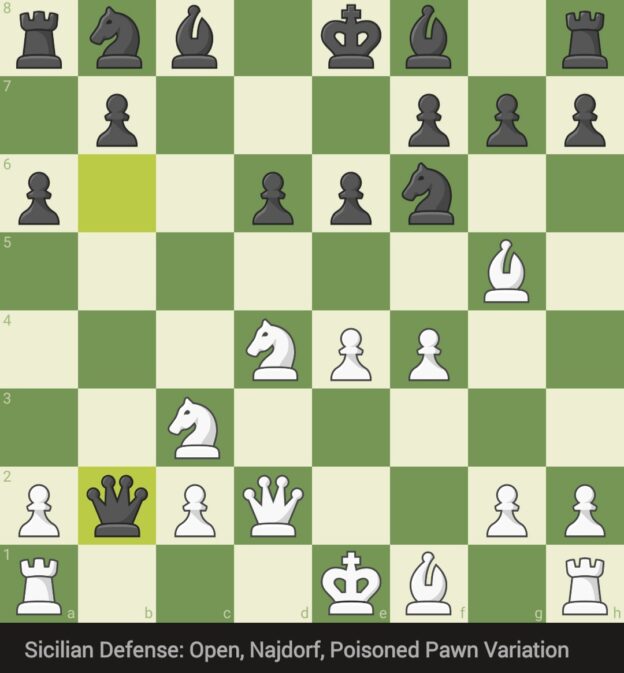In the realm of chess, few openings capture the imagination and stir the hearts of players quite like the Najdorf Variation of the Sicilian Defense. Within this already dynamic opening lies the Poisoned Pawn Variation, a daring and high-stakes line that has become legendary in the chess world. This essay explores the history, principles, and electrifying appeal of the Poisoned Pawn Variation.
Historical Origins:
The Najdorf Variation itself, named after the Argentine grandmaster Miguel Najdorf, emerged in the mid-20th century as a bold and aggressive response to 1.e4. Within this variation, the Poisoned Pawn Variation gained notoriety when players began to explore the complications of 1.e4 c5 2.Nf3 d6 3.d4 cxd4 4.Nxd4 Nf6 5.Nc3 a6 6.Bg5 e6 7.f4 Qb6. The “poisoned pawn” refers to White’s offer of the b2-pawn, which Black can capture with the queen. This seemingly risky gambit leads to a sharp and tactical battle.
Key Moves and Variations:
In the Poisoned Pawn Variation, White often follows up with 8.Qd2, protecting the b2-pawn and simultaneously launching an attack on Black’s queen. Black can then accept the poisoned pawn with 8…Qxb2, leading to a complex struggle where piece activity and king safety are paramount.
Principles and Characteristics:
- Material Imbalance: The Poisoned Pawn Variation is marked by a material imbalance. Black temporarily sacrifices material to seize the initiative and launch an aggressive counterattack against White’s king.
- King Safety: King safety is of utmost importance in this variation. Both sides must navigate treacherous waters as the central files open up, often leading to tactical fireworks around the kings.
- Complex Tactics: The Poisoned Pawn Variation is known for its intricate tactics. Players must calculate deeply and accurately to navigate the sharp lines and emerging complications.
Modern Relevance:
The Poisoned Pawn Variation remains highly relevant in contemporary chess. Top-level players continue to use it as a weapon of choice, both as White and as Black. Its capacity to create imbalanced positions and the rich tapestry of tactical possibilities ensure its enduring appeal.
Famous Practitioners:
Several legendary chess players have been associated with the Poisoned Pawn Variation. Players like Bobby Fischer, Garry Kasparov, and Vishwanathan Anand have demonstrated their mastery of this line, contributing to its enduring legacy.
Conclusion:
The Poisoned Pawn Variation of the Najdorf Sicilian is a thrilling embodiment of chess’s dynamic nature. It represents the relentless pursuit of initiative, tactical fireworks, and the unquenchable thirst for victory on the 64 squares. Beyond its theoretical intricacies, this variation serves as a reminder that chess is not just a game of material gains and losses but a battle of wits, courage, and creativity, where the willingness to embrace risk can lead to the most memorable and electrifying encounters on the chessboard.
